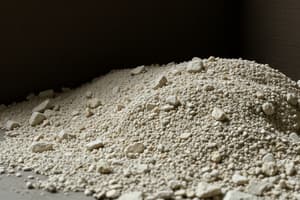Podcast
Questions and Answers
The final setting time period of cement helps in the safe removal of scaffolding.
The final setting time period of cement helps in the safe removal of scaffolding.
True (A)
During the final setting time period of cement, the primary chemical reaction with water is still ongoing.
During the final setting time period of cement, the primary chemical reaction with water is still ongoing.
False (B)
The compressive strength test of cement involves preparing three moulds of face area 60 cm2.
The compressive strength test of cement involves preparing three moulds of face area 60 cm2.
False (B)
In the compressive strength test, the rate of increasing load is constant at 350 kg/cm2 per minute.
In the compressive strength test, the rate of increasing load is constant at 350 kg/cm2 per minute.
The compressive strength of a cube in the test is determined by dividing the load at which it gets fractured by the cube's volume.
The compressive strength of a cube in the test is determined by dividing the load at which it gets fractured by the cube's volume.
The average of the compressive strengths of two cubes is considered for assessing the compressive strength of the cement sample.
The average of the compressive strengths of two cubes is considered for assessing the compressive strength of the cement sample.
The compressive strength testing machine applies a constant rate of load increase throughout the test.
The compressive strength testing machine applies a constant rate of load increase throughout the test.
Setting time and compressive strength are two interrelated properties tested in cement analysis.
Setting time and compressive strength are two interrelated properties tested in cement analysis.
The final setting time period of cement directly affects its compressive strength.
The final setting time period of cement directly affects its compressive strength.
The compressive strength test is conducted under non-standard temperature conditions.
The compressive strength test is conducted under non-standard temperature conditions.
Flashcards are hidden until you start studying



